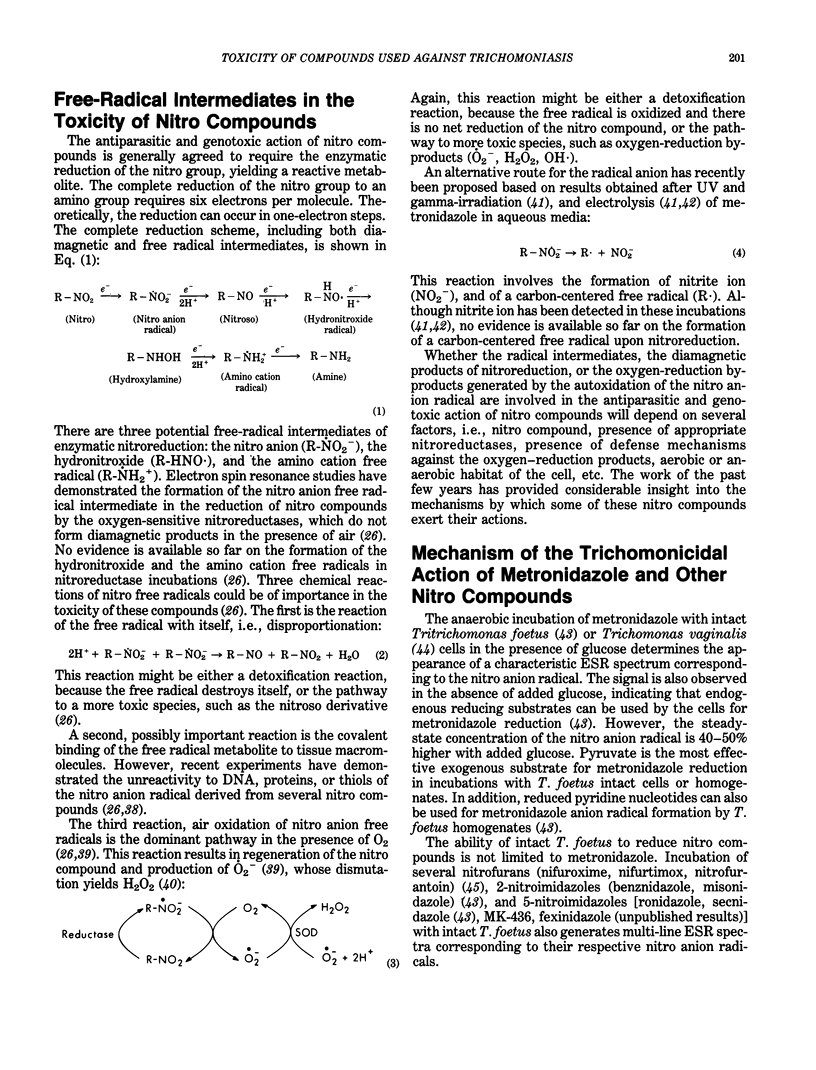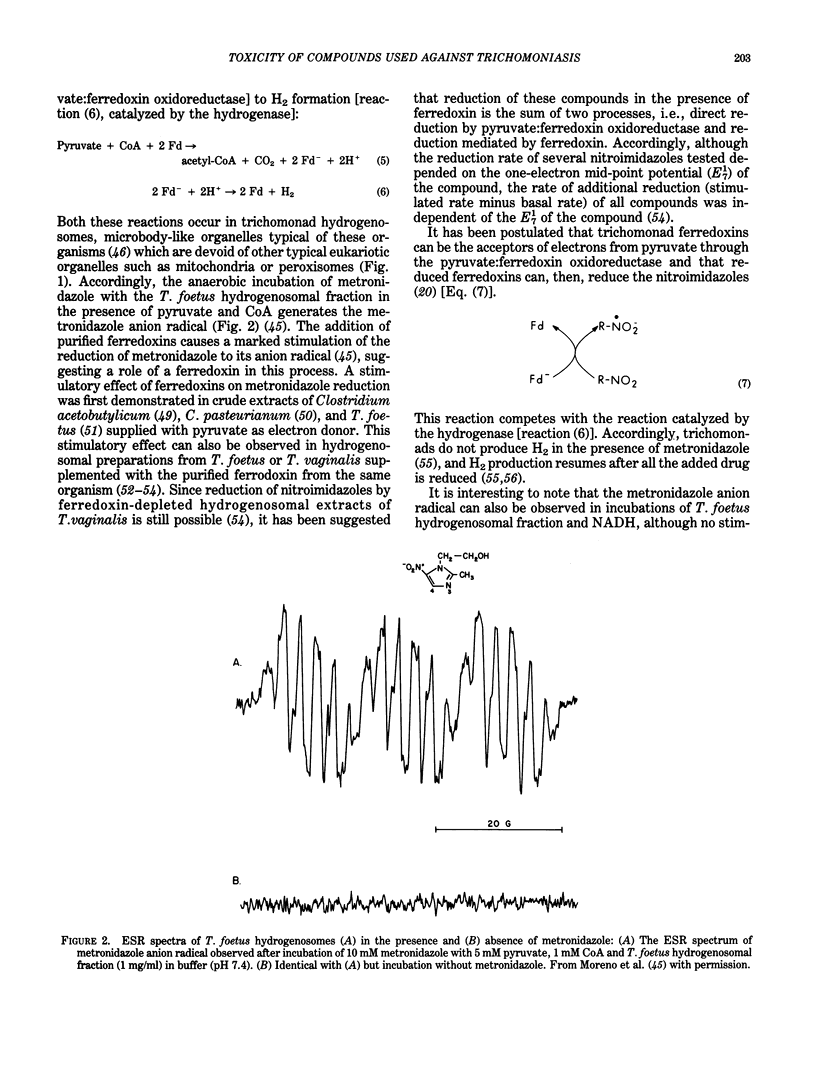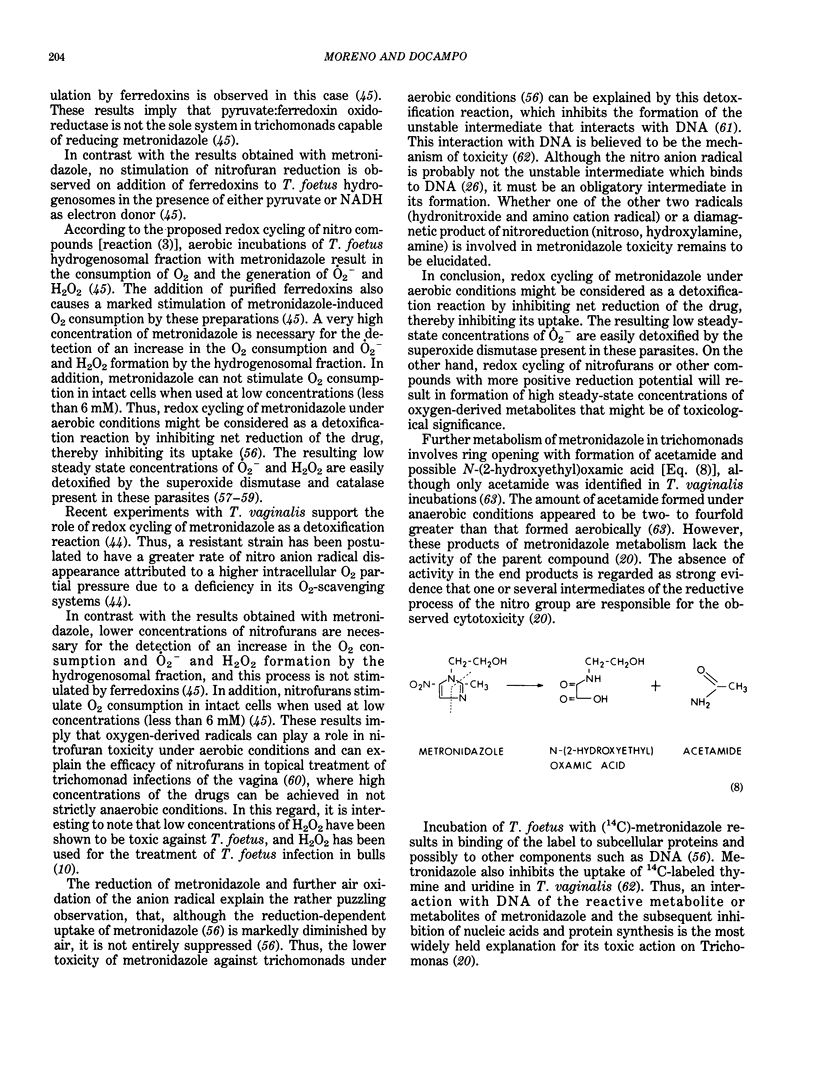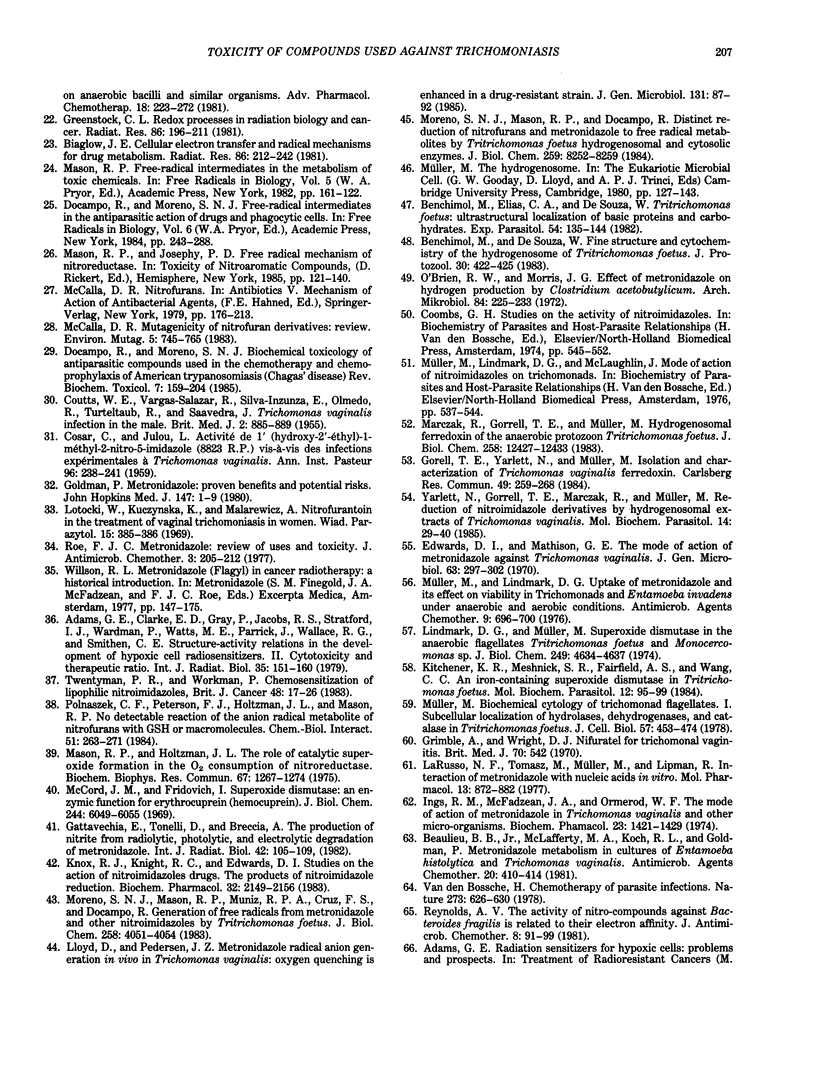Abstract
The mechanism of the trichomonicidal activity of metronidazole and other 5-nitroimidazoles appears to depend on the ferredoxin-mediated reduction of their nitro group, with generation of a reactive metabolite or metabolites which interact with DNA leading to a subsequent inhibition of nucleic acid and protein synthesis. Redox cycling of these compounds under aerobic conditions appears to be a detoxification reaction by inhibiting net reduction of the drugs, thereby inhibiting their uptake. On the other hand, redox cycling of nitrofurans or other compounds with more positive reduction potential results in formation of high steady-state concentrations of oxygen-derived metabolites that might be of toxicological significance. It seems likely that reduced metabolites of nitroimidazoles (perhaps through covalent binding to tissue macromolecules and/or thiols depletion) are also involved in the nitroimidazoles' toxic effects to animal tissues and in their mutagenic and carcinogenic action.
Full text
PDF









Images in this article
Selected References
These references are in PubMed. This may not be the complete list of references from this article.
- Adams G. E., Clarke E. D., Gray P., Jacobs R. S., Stratford I. J., Wardman P., Watts M. E., Parrick J., Wallace R. G., Smithen C. E. Structure-activity relationships in the development of hypoxic cell radiosensitizers. II. Cytotoxicity and therapeutic ratio. Int J Radiat Biol Relat Stud Phys Chem Med. 1979 Feb;35(2):151–160. doi: 10.1080/09553007914550161. [DOI] [PubMed] [Google Scholar]
- Adams G. E., Stratford I. J., Wallace R. G., Wardman P., Watts M. E. Toxicity of nitro compounds toward hypoxic mammalian cells in vitro: dependence on reduction potential. J Natl Cancer Inst. 1980 Mar;64(3):555–560. [PubMed] [Google Scholar]
- Baines E. J., McFadzean J. A. The action of metronidazole on anaerobic bacilli and similar organisms. Adv Pharmacol Chemother. 1981;18:223–272. doi: 10.1016/s1054-3589(08)60256-2. [DOI] [PubMed] [Google Scholar]
- Barker L. A., Green J. P., Szilagyi P. I. Acetylcholine-like activity in sciatic nerve--a re-evaluation. Biochem Pharmacol. 1979 Jul 1;28(13):2089–2090. doi: 10.1016/0006-2952(79)90228-4. [DOI] [PubMed] [Google Scholar]
- Beaulieu B. B., Jr, McLafferty M. A., Koch R. L., Goldman P. Metronidazole metabolism in cultures of Entamoeba histolytica and Trichomonas vaginalis. Antimicrob Agents Chemother. 1981 Sep;20(3):410–414. doi: 10.1128/aac.20.3.410. [DOI] [PMC free article] [PubMed] [Google Scholar]
- Benchimol M., De Souza W. Fine structure and cytochemistry of the hydrogenosome of Tritrichomonas foetus. J Protozool. 1983 May;30(2):422–425. doi: 10.1111/j.1550-7408.1983.tb02942.x. [DOI] [PubMed] [Google Scholar]
- Benchimol M., Elias C. A., de Souza W. Tritrichomonas foetus: ultrastructural localization of basic proteins and carbohydrates. Exp Parasitol. 1982 Oct;54(2):135–144. doi: 10.1016/0014-4894(82)90120-5. [DOI] [PubMed] [Google Scholar]
- Bertini B., Hornstein M. The epidemiology of trichomoniasis and the role of this infection in the development of carcinoma of the cervix. Acta Cytol. 1970 May;14(5):325–332. [PubMed] [Google Scholar]
- Biaglow J. E. Cellular electron transfer and radical mechanisms for drug metabolism. Radiat Res. 1981 May;86(2):212–242. [PubMed] [Google Scholar]
- Birnbaum H. Untersuchungen über trichomonazide Wirkung verschiedener Nitrofuranpräparate. Zentralbl Gynakol. 1967 Sep 9;89(36):1303–1313. [PubMed] [Google Scholar]
- Brown M. T. Trichomoniasis. Practitioner. 1972 Nov;209(253):639–644. [PubMed] [Google Scholar]
- COSAR C., JULOU L. Activité de l'(hydroxy-2'éthyl)-1 méthyl-2 nitro-5 imidazole (8.823 R. P.) vis-à-vis des infections expérimentales à Trichomonas vaginalis. Ann Inst Pasteur (Paris) 1959 Feb;96(2):238–241. [PubMed] [Google Scholar]
- COUTTS W. E., VARGAS-SALAZAR R., SILVA-INZUNZA E., OLMEDO R., TURTELTAUB R., SAAVEDRA J. Trichomonas vaginalis infection in the male. Br Med J. 1955 Oct 8;2(4944):885–889. doi: 10.1136/bmj.2.4944.885. [DOI] [PMC free article] [PubMed] [Google Scholar]
- Chessin H., McLaughlin T., Mroczkowski Z., Rupp W. D., Low K. B. Radiosensitization, mutagenicity, and toxicity of Escherichia coli by several nitrofurans and nitroimidazoles. Radiat Res. 1978 Aug;75(2):424–431. [PubMed] [Google Scholar]
- Chin J. B., Sheinin D. M., Rauth A. M. Screening for the mutagenicity of nitro-group containing hypoxic cell radiosensitizers using Salmonella typhimurium strains TA 100 and TA98. Mutat Res. 1978 Sep;58(1):1–10. [PubMed] [Google Scholar]
- Chrystal E. J., Koch R. L., Goldman P. Metabolites from the reduction of metronidazole by xanthine oxidase. Mol Pharmacol. 1980 Jul;18(1):105–111. [PubMed] [Google Scholar]
- Clarke E. D., Wardman P., Goulding K. H. Anaerobic reduction of nitroimidazoles by reduced flavin mononucleotide and by xanthine oxidase. Biochem Pharmacol. 1980 Oct 1;29(19):2684–2687. doi: 10.1016/0006-2952(80)90087-8. [DOI] [PubMed] [Google Scholar]
- Connor T. H., Stoeckel M., Evrard J., Legator M. S. The contribution of metronidazole and two metabolites to the mutagenic activity detected in urine of treated humans and mice. Cancer Res. 1977 Feb;37(2):629–633. [PubMed] [Google Scholar]
- Connor T. H., Stoeckel M., Evrard J., Legator M. S. The contribution of metronidazole and two metabolites to the mutagenic activity detected in urine of treated humans and mice. Cancer Res. 1977 Feb;37(2):629–633. [PubMed] [Google Scholar]
- Coulter J. R., Turner J. V. Tinidazole (TNZ) ethyl[2-(2-METHYL-5-NITro-1-imidazolyl) ethyl]sulphone) is mutagenic in a Salmonella Typhimurium assay. Mutat Res. 1978 Mar;57(1):97–101. doi: 10.1016/0027-5107(78)90239-7. [DOI] [PubMed] [Google Scholar]
- Declerck P. J., De Ranter C. J., Volckaert G. Base specific interaction of reductively activated nitroimidazoles with DNA. FEBS Lett. 1983 Nov 28;164(1):145–148. doi: 10.1016/0014-5793(83)80038-6. [DOI] [PubMed] [Google Scholar]
- Edwards D. I., Knox R. J., Knight R. C. Structure-cytotoxicity relationships of nitroimidazoles in an in vitro system. Int J Radiat Oncol Biol Phys. 1982 Mar-Apr;8(3-4):791–793. doi: 10.1016/0360-3016(82)90736-2. [DOI] [PubMed] [Google Scholar]
- Edwards D. I., Mathison G. E. The mode of action of metronidazole against Trichomonas vaginalis. J Gen Microbiol. 1970 Nov;63(3):297–302. doi: 10.1099/00221287-63-3-297. [DOI] [PubMed] [Google Scholar]
- Felman Y. M., Nikitas J. A. Trichomoniasis, candidiasis, and Corynebacterium vaginale vaginitis. N Y State J Med. 1979 Sep;79(10):1563–1566. [PubMed] [Google Scholar]
- Fowler J. F., Adams G. E., Denekamp J. Radiosensitizers of hypoxic cells in solid tumors. Cancer Treat Rev. 1976 Dec;3(4):227–256. doi: 10.1016/s0305-7372(76)80012-6. [DOI] [PubMed] [Google Scholar]
- Fowler W., Hussain M. Nifuratel (Magmilor) in trichomonal vaginitis. Br J Vener Dis. 1968 Dec;44(4):331–333. doi: 10.1136/sti.44.4.331. [DOI] [PMC free article] [PubMed] [Google Scholar]
- Gattavecchia E., Tonelli D., Breccia A., Roffia S. The production of nitrite from radiolytic, photolytic and electrolytic degradation of metronidazole. Int J Radiat Biol Relat Stud Phys Chem Med. 1982 Jul;42(1):105–109. doi: 10.1080/09553008214550961. [DOI] [PubMed] [Google Scholar]
- Goldman P. Metronidazole: proven benefits and potential risks. Johns Hopkins Med J. 1980 Jul;147(1):1–9. [PubMed] [Google Scholar]
- Greenstock C. L. Redox processes in radiation biology and cancer. Radiat Res. 1981 May;86(2):196–211. [PubMed] [Google Scholar]
- Ings R. M., McFadzean J. A., Ormerod W. E. The fate of metronidazole and tis implications in chemotherapy. Xenobiotica. 1975 Apr;5(4):223–235. doi: 10.3109/00498257509052069. [DOI] [PubMed] [Google Scholar]
- Ings R. M., McFadzean J. A., Ormerod W. E. The mode of action of metronidazole in Trichomonas vaginalis and other micro-organisms. Biochem Pharmacol. 1974 May 1;23(9):1421–1429. doi: 10.1016/0006-2952(74)90362-1. [DOI] [PubMed] [Google Scholar]
- Jones A. V., Harwood J. L., Stratford M. R., Stumpf P. K. Inhibition of plant fatty acid synthesis by nitroimidazoles. Biochem J. 1981 Jul 15;198(1):193–198. doi: 10.1042/bj1980193. [DOI] [PMC free article] [PubMed] [Google Scholar]
- KOSS L. G., WOLINSKA W. H. Trichomonas vaginalis cervicitis and its relationship to cervical cancer. A histocytological study. Cancer. 1959 Nov-Dec;12:1171–1193. doi: 10.1002/1097-0142(195911/12)12:6<1171::aid-cncr2820120613>3.0.co;2-4. [DOI] [PubMed] [Google Scholar]
- Kawamura N. Metronidazole and tinidazole in a single large dose for treating urogenital infections with Trichomonas vaginalis in men. Br J Vener Dis. 1978 Apr;54(2):81–83. doi: 10.1136/sti.54.2.81. [DOI] [PMC free article] [PubMed] [Google Scholar]
- Kitchener K. R., Meshnick S. R., Fairfield A. S., Wang C. C. An iron-containing superoxide dismutase in Tritrichomonas foetus. Mol Biochem Parasitol. 1984 May;12(1):95–99. doi: 10.1016/0166-6851(84)90047-1. [DOI] [PubMed] [Google Scholar]
- Knox R. J., Knight R. C., Edwards D. I. Interaction of nitroimidazole drugs with DNA in vitro: structure-activity relationships. Br J Cancer. 1981 Nov;44(5):741–745. doi: 10.1038/bjc.1981.261. [DOI] [PMC free article] [PubMed] [Google Scholar]
- Knox R. J., Knight R. C., Edwards D. I. Studies on the action of nitroimidazole drugs. The products of nitroimidazole reduction. Biochem Pharmacol. 1983 Jul 15;32(14):2149–2156. doi: 10.1016/0006-2952(83)90220-4. [DOI] [PubMed] [Google Scholar]
- Koch R. L., Chrystal E. J., Beaulieu B. B., Jr, Goldman P. Acetamide--a metabolite of metronidazole formed by the intestinal flora. Biochem Pharmacol. 1979 Dec 15;28(24):3611–3615. doi: 10.1016/0006-2952(79)90407-6. [DOI] [PubMed] [Google Scholar]
- Koch R. L., Goldman P. The anaerobic metabolism of metronidazole forms N-(2-hydroxyethyl)-oxamic acid. J Pharmacol Exp Ther. 1979 Mar;208(3):406–410. [PubMed] [Google Scholar]
- Kock R. L., Beaulieu B. B., Jr, Chrystal E. J., Goldman P. A metronidazole metabolite in human urine and its risk. Science. 1981 Jan 23;211(4480):398–400. doi: 10.1126/science.7221546. [DOI] [PubMed] [Google Scholar]
- Krieger J. N. Urologic aspects of trichomoniasis. Invest Urol. 1981 May;18(8):411–417. [PubMed] [Google Scholar]
- LaRusso N. F., Lindmark D. G., Müller M. Biliary and renal excretion, hepatic metabolism, and hepatic subcellular distribution of metronidazole in the rat. Biochem Pharmacol. 1978;27(18):2247–2254. doi: 10.1016/0006-2952(78)90084-9. [DOI] [PubMed] [Google Scholar]
- LaRusso N. F., Tomasz M., Müller M., Lipman R. Interaction of metronidazole with nucleic acids in vitro. Mol Pharmacol. 1977 Sep;13(5):872–882. [PubMed] [Google Scholar]
- Lindmark D. G., Müller M. Antitrichomonad action, mutagenicity, and reduction of metronidazole and other nitroimidazoles. Antimicrob Agents Chemother. 1976 Sep;10(3):476–482. doi: 10.1128/aac.10.3.476. [DOI] [PMC free article] [PubMed] [Google Scholar]
- Lindmark D. G., Müller M. Superoxide dismutase in the anaerobic flagellates, Tritrichomonas foetus and Monocercomonas sp. J Biol Chem. 1974 Jul 25;249(14):4634–4637. [PubMed] [Google Scholar]
- Lloyd D., Pedersen J. Z. Metronidazole radical anion generation in vivo in Trichomonas vaginalis: oxygen quenching is enhanced in a drug-resistant strain. J Gen Microbiol. 1985 Jan;131(1):87–92. doi: 10.1099/00221287-131-1-87. [DOI] [PubMed] [Google Scholar]
- Lotocki W., Kuczyńska K., Malarewicz A. Nitrofurantoina w leczeniu rzesistkowicy pochwy u kobiet. Wiad Parazytol. 1969;15(3):385–386. [PubMed] [Google Scholar]
- Marczak R., Gorrell T. E., Müller M. Hydrogenosomal ferredoxin of the anaerobic protozoon, Tritrichomonas foetus. J Biol Chem. 1983 Oct 25;258(20):12427–12433. [PubMed] [Google Scholar]
- Mason P. R. Trichomoniasis. New ideas on an old disease. S Afr Med J. 1980 Nov 22;58(21):857–859. [PubMed] [Google Scholar]
- Mason R. P., Holtzman J. L. The role of catalytic superoxide formation in the O2 inhibition of nitroreductase. Biochem Biophys Res Commun. 1975 Dec 15;67(4):1267–1274. doi: 10.1016/0006-291x(75)90163-1. [DOI] [PubMed] [Google Scholar]
- McCalla D. R. Mutagenicity of nitrofuran derivatives: review. Environ Mutagen. 1983;5(5):745–765. doi: 10.1002/em.2860050512. [DOI] [PubMed] [Google Scholar]
- McCord J. M., Fridovich I. Superoxide dismutase. An enzymic function for erythrocuprein (hemocuprein). J Biol Chem. 1969 Nov 25;244(22):6049–6055. [PubMed] [Google Scholar]
- McLaren L. C., Davis L. E., Healy G. R., James C. G. Isolation of Trichomonas vaginalis from the respiratory tract of infants with respiratory disease. Pediatrics. 1983 Jun;71(6):888–890. [PubMed] [Google Scholar]
- McNab W. L. The "other" venereal diseases: herpes simplex, trichomoniasis and candidiasis. J Sch Health. 1979 Feb;49(2):79–83. doi: 10.1111/j.1746-1561.1979.tb05292.x. [DOI] [PubMed] [Google Scholar]
- Meingassner J. G., Heyworth P. G. Intestinal and urogenital flagellates. Antibiot Chemother (1971) 1981;30:163–202. doi: 10.1159/000398097. [DOI] [PubMed] [Google Scholar]
- Miwa G. T., West S. B., Walsh J. S., Wolf F. J., Lu A. Y. Drug residue formation from ronidazole, a 5-nitroimidazole. III. Studies on the mechanism of protein alkylation in vitro. Chem Biol Interact. 1982 Sep;41(3):297–312. doi: 10.1016/0009-2797(82)90107-7. [DOI] [PubMed] [Google Scholar]
- Moreno S. N., Mason R. P., Docampo R. Distinct reduction of nitrofurans and metronidazole to free radical metabolites by Tritrichomonas foetus hydrogenosomal and cytosolic enzymes. J Biol Chem. 1984 Jul 10;259(13):8252–8259. [PubMed] [Google Scholar]
- Moreno S. N., Mason R. P., Muniz R. P., Cruz F. S., Docampo R. Generation of free radicals from metronidazole and other nitroimidazoles by Tritrichomonas foetus. J Biol Chem. 1983 Apr 10;258(7):4051–4054. [PubMed] [Google Scholar]
- Müller M. Action of clinically utilized 5-nitroimidazoles on microorganisms. Scand J Infect Dis Suppl. 1981;26:31–41. [PubMed] [Google Scholar]
- Müller M., Lindmark D. G. Uptake of metronidazole and its effect on viability in trichomonads and Entamoeba invadens under anaerobic and aerobic conditions. Antimicrob Agents Chemother. 1976 Apr;9(4):696–700. doi: 10.1128/aac.9.4.696. [DOI] [PMC free article] [PubMed] [Google Scholar]
- O'Brien R. W., Morris J. G. Effect of metronidazole on hydrogen production by Clostridium acetobutylicum. Arch Mikrobiol. 1972;84(3):225–233. doi: 10.1007/BF00425200. [DOI] [PubMed] [Google Scholar]
- Ong T., Slade B., de Serres F. J. Mutagenicity and mutagenic specificity of metronidazole and niridazole in Neurospora crassa. J Environ Pathol Toxicol. 1979 Mar-Apr;2(4):1109–1118. [PubMed] [Google Scholar]
- Perez-Reyes E., Kalyanaraman B., Mason R. P. The reductive metabolism of metronidazole and ronidazole by aerobic liver microsomes. Mol Pharmacol. 1980 Mar;17(2):239–244. [PubMed] [Google Scholar]
- Polnaszek C. F., Peterson F. J., Holtzman J. L., Mason R. P. No detectable reaction of the anion radical metabolite of nitrofurans with reduced glutathione or macro-molecules. Chem Biol Interact. 1984 Oct;51(3):263–271. doi: 10.1016/0009-2797(84)90152-2. [DOI] [PubMed] [Google Scholar]
- Raleigh J. A., Liu S. F. Reductive fragmentation of 2-nitroimidazoles in the presence of nitroreductases--glyoxal formation from misonidazole. Biochem Pharmacol. 1983 Apr 15;32(8):1444–1446. doi: 10.1016/0006-2952(83)90460-4. [DOI] [PubMed] [Google Scholar]
- Reynolds A. V. The activity of nitro-compounds against Bacteroides fragilis is related to their electron affinity. J Antimicrob Chemother. 1981 Aug;8(2):91–99. doi: 10.1093/jac/8.2.91. [DOI] [PubMed] [Google Scholar]
- Roe F. J. Metronidazole: review of uses and toxicity. J Antimicrob Chemother. 1977 May;3(3):205–212. doi: 10.1093/jac/3.3.205. [DOI] [PubMed] [Google Scholar]
- Rosenkranz H. S., Speck W. T. Mutagenicity of metronidazole: activation by mammalian liver microsomes. Biochem Biophys Res Commun. 1975 Sep 16;66(2):520–525. doi: 10.1016/0006-291x(75)90541-0. [DOI] [PubMed] [Google Scholar]
- Siemann D. W., Morrissey S., Wolf K. In vivo potentiation of 1-(2-chloroethyl)-3-cyclohexyl-1-nitrosourea by the radiation sensitizer benznidazole. Cancer Res. 1983 Mar;43(3):1010–1013. [PubMed] [Google Scholar]
- Twentyman P. R., Workman P. Chemosensitization by lipophilic nitroimidazoles. Br J Cancer. 1983 Jul;48(1):17–26. doi: 10.1038/bjc.1983.152. [DOI] [PMC free article] [PubMed] [Google Scholar]
- Van den Bossche H. Chemotherapy of parasite infections. Nature. 1978 Jun 22;273(5664):626–630. doi: 10.1038/273626a0. [DOI] [PubMed] [Google Scholar]
- Varghese A. J., Whitmore G. F. Modification of guanine derivatives by reduced 2-nitroimidazoles. Cancer Res. 1983 Jan;43(1):78–82. [PubMed] [Google Scholar]
- Voogd C. E., Van der Stel J. J., Jacobs J. J. The mutagenic action of nitroimidazoles. I. Metronidazole, nimorazole, dimetridazole and ronidazole. Mutat Res. 1974 Dec;26(6):483–490. doi: 10.1016/s0027-5107(74)80049-7. [DOI] [PubMed] [Google Scholar]
- Voogd C. E., van der Stel J. J., Jacobs J. J. The mutagenic action of nitroimidazoles. IV. A comparison of the mutagenic action of several nitroimidazoles and some imidazoles. Mutat Res. 1979 Mar;66(3):207–221. doi: 10.1016/0165-1218(79)90082-x. [DOI] [PubMed] [Google Scholar]
- Wardman P. The use of nitroaromatic compounds as hypoxic cell radiosensitizers. Curr Top Radiat Res Q. 1977 Aug;11(4):347–398. [PubMed] [Google Scholar]
- West S. B., Wislocki P. G., Fiorentini K. M., Alvaro R., Wolf F. J., Lu A. Y. Drug residue formation from ronidazole, a 5-nitroimidazole. I. Characterization of in vitro protein alkylation. Chem Biol Interact. 1982 Sep;41(3):265–279. doi: 10.1016/0009-2797(82)90105-3. [DOI] [PubMed] [Google Scholar]
- West S. B., Wislocki P. G., Wolf F. J., Lu A. Y. Drug residue formation from ronidazole, a 5-nitroimidazole. II. Involvement of microsomal NADPH-cytochrome P-450 reductase in protein alkylation in vitro. Chem Biol Interact. 1982 Sep;41(3):281–296. doi: 10.1016/0009-2797(82)90106-5. [DOI] [PubMed] [Google Scholar]
- Wislocki P. G., Bagan E. S., Cook M. M., Bradley M. O., Wolf F. J., Lu A. Y. Drug residue formation from ronidazole, a 5-nitroimidazole. VI. Lack of mutagenic activity of reduced metabolites and derivatives of ronidazole. Chem Biol Interact. 1984 Apr;49(1-2):27–38. doi: 10.1016/0009-2797(84)90050-4. [DOI] [PubMed] [Google Scholar]
- Wislocki P. G., Bagan E. S., Vandenheuvel W. J., Walker R. W., Alvaro R. F., Arison B. H., Lu A. Y., Wolf F. J. Drug residue formation from ronidazole, a 5-nitroimidazole. V. Cysteine adducts formed upon reduction of ronidazole by dithionite or rat liver enzymes in the presence of cysteine. Chem Biol Interact. 1984 Apr;49(1-2):13–25. doi: 10.1016/0009-2797(84)90049-8. [DOI] [PubMed] [Google Scholar]
- Workman P., Twentyman P. R., Lee F. Y., Walton M. I. Drug metabolism and chemosensitization. Nitroimidazoles as inhibitors of drug metabolism. Biochem Pharmacol. 1983 Mar 1;32(5):857–864. doi: 10.1016/0006-2952(83)90588-9. [DOI] [PubMed] [Google Scholar]
- Yarlett N., Gorrell T. E., Marczak R., Müller M. Reduction of nitroimidazole derivatives by hydrogenosomal extracts of Trichomonas vaginalis. Mol Biochem Parasitol. 1985 Jan;14(1):29–40. doi: 10.1016/0166-6851(85)90103-3. [DOI] [PubMed] [Google Scholar]



